Bent But Not Broken
CHRISTCHURCH QUAKE SEPTEMBER 4TH 2010
This personal report by Stuart Thomson highlights the validity of the claim previously made in Scope that light metal roof cladding not only can save money but can save lives as well. Heavy tile roofs did not fare well but metal roofs were bent but not broken.
Visiting Christchurch was déjà vu for the writer because of the memory of the two Masterton earthquakes which occurred in 1942, both within five weeks of one another which changed Wellington in the same way that Christchurch has now been changed forever.
Fortunately the Wellington (7.2 & 6.8) quakes also struck at night with only one person killed in comparison to the 1931 Napier (7.8) earthquake which struck at about 11 o’clock in the morning and killed 256 people. Compare these with 2010 Haiti (7.1) quake which struck the capital Port- Au-Prince at about 5 p.m. killing 230,000.
Wellington’s Manners Street was closed for four months in 1942 while the brick and rubble was cleared 20,000 chimneys had to come down along with many buildings in the CBD. This was wartime and my job was to repair damaged roofs and to inspect chimneys and dismantle them. As a result of the Wellington quake the Earthquake & War Damage Commission was set up in 1945.
The Darfield quake (as it is officially known) should not have come as a surprise to Christchurch, like Wellington it was (and is) just a manner of when, not if. Christchurch’s last major earthquake happened in 1922 at Motunau. The seismic map of NZS 3604:1999 shows Canterbury fairly and squarely in zones A, B, and C, low medium and high all within 30 km of one another! Was that ever possible? The proposed seismic map intended for publication in the New Zealand Standard 3604 (unchanged in that respect) to be published in 2011 will have to be drawn again.
The obvious damage inspected by the writer within a week of the disaster appeared to be mostly divided into two classes of buildings. Those that were brick and had simply fallen down and houses that had suffered subsidence due to liquefaction. While the quake struck at the best time of the day, it also struck at the worst time of the year – when winter rains had saturated the ground.
Amongst the things to be learned from Christchurch quake was the remarkable redundancy provided as a safety factor (undesigned) for all those buildings with metal roof cladding. The diaphragm action of the roof cladding literally can hold the building up as illustrated by this picture of the 160 year old Dean Homestead at Home Bush.
Also shown is the ability of hip roofs to hold the roof structure together, which is not surprising either as the remarkable photo of the Dunedin suburb of Abbotsford 1978 landslide shows. Hipped roofs, unlike the tile roofed houses that disintegrated before they hit the bottom, kept some of the 69 houses intact.
Even metal tile roofs managed to hold the building together in Christchurch!
N.B. The corrugate verandah would have saved a king hit!
Not so lucky were the tile roofs which were destroyed by the brick chimneys falling on them. Heavy roofs with concrete tiles swaying in a 7.1 quake destroyed many roofs in Christchurch.
This is supported in a report on residential houses performance in the Darfield earthquake co-authored by Professor of Timber Structures at the University of Canterbury, Professor Andy Buchanan. In it he compares the performance of roofs under collapsing chimneys, noting that those falling onto corrugated steel roofing “often caused no further damage” while those falling onto tile roofs “more often fell through into the house, sometimes causing further structural damage and potential loss of life. Buildings with heavy roofs tended to have more lining damage than those with light roofs”.
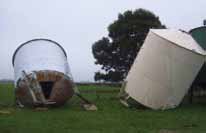
While it is not intended to take advantage of the Christchurch disaster to promote metal roof cladding, the results are selfevident. Many years ago the concrete tile industry launched an advertising campaign to denigrate metal roof cladding showing an ancient corrugated iron roof alongside a new concrete tile one. This prompted a response from the New Zealand Metal Roofing Manufacturers and their advertising agency suggested an elephant campaign and produced this ad to make the point.
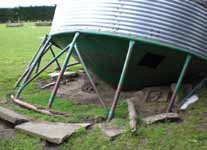 The point was well made with the average concrete tile roof weighing five tonnes, severe strain is placed on the roof structure and many Christchurch buildings will require rebuilding to restore them. Many will end up with a new metal tile roof because the old clay or concrete patterns will not be available to repair the holes where brick chimneys have destroyed them.
The point was well made with the average concrete tile roof weighing five tonnes, severe strain is placed on the roof structure and many Christchurch buildings will require rebuilding to restore them. Many will end up with a new metal tile roof because the old clay or concrete patterns will not be available to repair the holes where brick chimneys have destroyed them.
The elephants have done their work. Not only did metal roofs stand up well but vulnerable silos miraculously survived, although like houses they relied on good foundations. Corrugated galvanised Steel silos made by MRM member company Dan Cosgrove Ltd of Timaru have been used for years for the storage of grain on the Canterbury plains. They have stood up well; that is until September 4th when a lot of their foundations let them down. Tonnes of grain tossed around by the force of the quake put stress onto the concrete or steel that was not built for such an event.
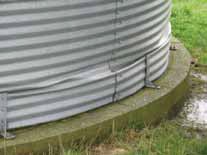 N.B. Tanks and silos built on foundations designed and detailed for earthquake resistance incorporating the lessons learned from the 1987 Edgecumbe earthquake performed very well showing no damage or loss of function.
N.B. Tanks and silos built on foundations designed and detailed for earthquake resistance incorporating the lessons learned from the 1987 Edgecumbe earthquake performed very well showing no damage or loss of function.
The moral of that story is: a building is only as good as its foundations.
Some steel framed warehouses were affected when their contents fell onto them while in others roof cladding slid and moved to slot the fixing holes as shown by the following photo; another good reason for using load spreading washers.
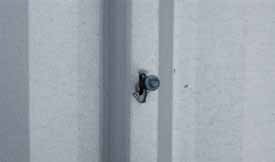
Our Industry responded quickly New Zealand Steel committed $500,000 in steel products and building solutions towards recovery efforts in the earthquake affected Canterbury region. New Zealand Steel President Mr Ross Murray said: “Many of our people have family and friends whose lives have been affected by the earthquake. “We will work closely with our customers and others in the region to identify community rebuilding projects that will be supported by New Zealand Steel’s $500,000 products and building solutions package,” Mr Murray said. Although Cantabs may have not noticed it, for the last hundred years they also have been living in ‘the shaky Isles’ centred on the ‘Ring of Fire’, close to the edge of the Pacific and Australian plates.
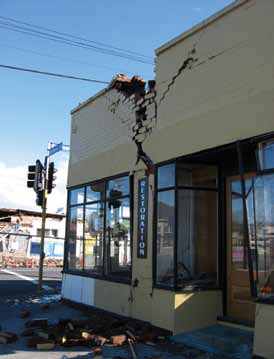 The Ring of Fire is an area in the Pacific Ocean basin where 90% of the world’s earthquakes and most volcanic eruptions occur. It has 452 volcanoes and is home to over 75% of the world’s active and dormant volcanoes.
The Ring of Fire is an area in the Pacific Ocean basin where 90% of the world’s earthquakes and most volcanic eruptions occur. It has 452 volcanoes and is home to over 75% of the world’s active and dormant volcanoes.
So if you want to live in God’s own – be prepared because the risk goes with the territory!
NZ has some of the world’s top experts in earthquake engineering for building, many of whom come out of the University of Canterbury’s Engineering Department This includes our own metal-man ex HERA Dr Charles Clifton, who has the hybrid vigour of both a Canterbury and Auckland background and who is now Associate Professor of Engineering at Auckland University. Like most countries that experience frequent seismic activity, New Zealand has incorporated earthquake design principles into its building code and recently published NZS 1170.5:2004.
What we have learned is how to design and construct buildings out of material that is ductile so that it can bend like timber and steel, however the increases in seismic resistance building that have occurred regularly since 1932, have come at a cost and have been criticised for being prohibitively expensive. This is the main reason why local authorities have been procrastinating for years on upgrading their EPB’s (Earthquake prone buildings).
Building Act 2004 Part 2, 122 Meaning of earthquake-prone building.
(1) A building is earthquake prone for the purposes of this Act if, having regard to its condition and to the ground on which is built, and because of its construction, the building—
(a) will have its ultimate capacity exceeded in a moderate earthquake (as defined in the regulations); and
(b) would be likely to collapse causing—
(i) injury or death to persons in the building or to persons on any other property; or
(ii) damage to any other property.
(2) Subsection (1) does not apply to a building that is used wholly or mainly for residential purposes unless the building—
(a) comprises 2 or more storeys; and
(b) contains 3 or more household units.
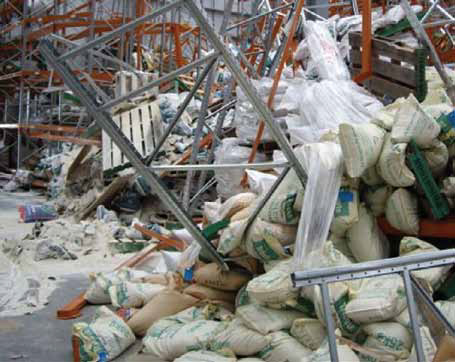
A moderate earthquake is legally defined as: an earthquake that would generate shaking at the site of the building that is of the same duration as, but that is one-third as strong as, the earthquake shaking (determined by normal measures of acceleration, velocity and displacement) that would be used to design a new building at the site. We may have learnt a lot about the techniques of building in a seismic country but are we prepared for the high social cost to upgrade? An old car gets to the stage when a WOF simply is going to cost too much and the car is a menace to other road users. There are a lot of NZ buildings without a seismic WOF.
What Price of New Zealand’s Architectural Heritage? Mayor Parker’s idea of a think tank of Architects may be a good idea but a boatload of engineers would be a better one.
Noted NZ Engineer AdamThornton of Dunning Thornton says “ Crucially, some owners appear to have a modus operandi of shopping around between consultants to find those recommending the lowest target strength i.e. to achieve 34% NBS (New Building Standard). It is my view that this is damaging to the profession and Engineering consultants should be acting cooperatively, recommending costeffective solutions (measured on a whole of life basis) and leading their clients and the public at large to realise the benefits of appropriate retrofit.
How often can we expect the earthquake the big snowfall or the cyclone to happen? NZS 1170.5:2004
The Ultimate Limit State (ULS) for buildings of normal use (importance level 2) is typically based around earthquake with a return period of 500-years (10% probability in an assumed 50-year life).
The Standard draws attention to the fact that the prediction of the effects of an earthquake on soil, e.g. liquefaction, is outside the scope of NZS 1170.5:2004 and that the ‘advice of appropriate experts should be sought for these considerations. It also states that Fatality risk is at an acceptable
level. but does not elaborate
A look at the return period map (NZS 1170.5 Fig C2.3) might have some people shifting their place of abode from the top of the South Island and the bottom of
the North Island for the apparent (recent historical) safety of Dunedin or Auckland.
But don’t be too sure – we are not called the ‘Shaky Isles” for nothing Learning from the past is not something that we are good at. There are already existing improvements in seismic design available without incurring a great deal of extra cost. We must build light. We must build ‘Life-safe’ buildings.
Ribbed or waffle residential concrete slab construction with reinforcing would have saved a lot of residential damage when built on alluvial ground. You can’t avoid damage with lateral spread but you can prevent building collapse. Gable end buildings never have performed well and are more vulnerable in wind and earthquake. All double brick gable ends must come down. All brick parapets must come down – a lot are down already!
The diaphragm action of metal roof cladding is not normally part of a calculated design but comes free as a bonus for all those specifying metal cladding. Metal roofs only require half the bracing of heavy roofs and ‘Stressed skin design’ can be used to reduce the bracing requirements further but in an earthquake it can also save lives as well.
The predictions of seismologists (weather forecasters) are said to be no more than hopes distorted by primitive science however MetService Weather Ambassador, Bob McDavitt told me he never gets the weather forecast wrong – just the timing.
During El Niño,(little boy) in summer New Zealand experiences stronger or more frequent westerly winds, with rain in the west and drought in the east. In winter southerly winds bring colder conditions to both land and sea while in spring and autumn southwesterly winds are more common.
La Niña (little girl) brings Northeasterly winds with moist, rainy conditions to the northeast of the North Island, and reduced rainfall to the south and southwest of the South Island. Although there are regional and seasonal exceptions warmer than normal temperatures occur over much of the country and central Otago and South Canterbury, can experience drought. Now in 2010 the little girl is taking control and I could predict the likelihood of cyclone force winds in the North this summer! To predict the weather is one thing,- at least you can look out the window and form your own opinion but to foretell an earthquake is rather more difficult. It is some consolation that if you build well for wind you should fare well in the shake and many industrial buildings in the Darfield and Rolleston areas stand undamaged as testament to this.
